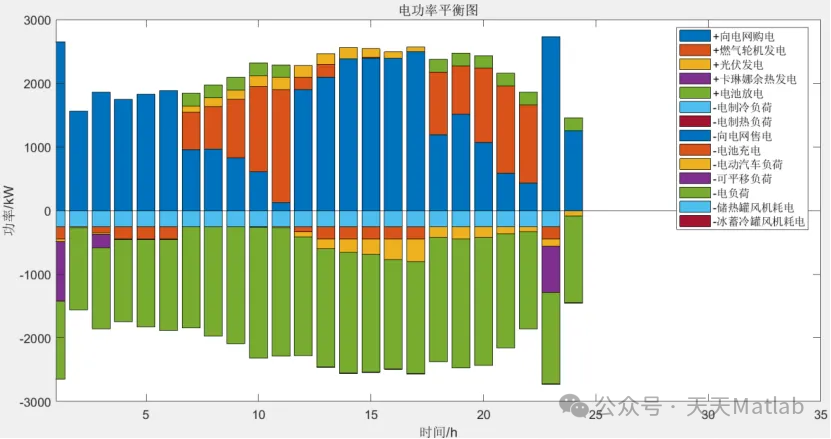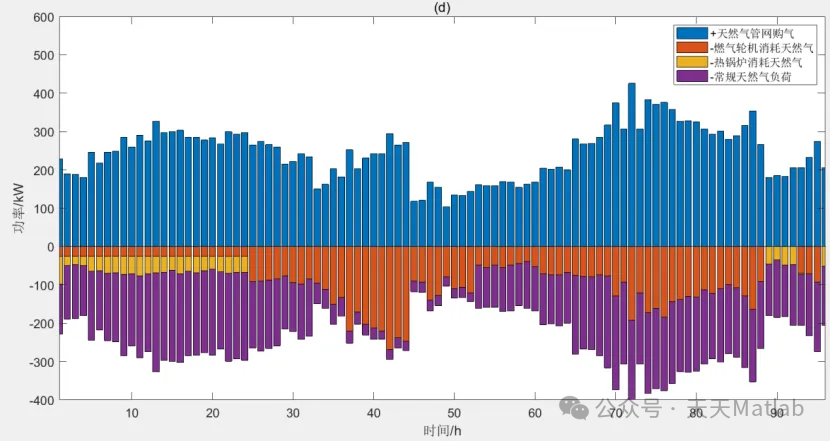✅ Author Profile: A research enthusiast and Matlab simulation developer, skilled in data processing, modeling simulation, program design, complete code acquisition, paper reproduction, and research simulation.
🍎 Previous reviews can be found on my personal homepage:Matlab Research Studio
🍊 Personal motto: Knowledge through exploration, complete Matlab code and simulation consultation available via private message.
🔥 Content Introduction
Day-Ahead Scheduling
- Objective: To minimize the overall operating costs of smart buildings, considering electricity procurement costs, equipment operation and maintenance costs, while meeting the basic electricity needs and comfort requirements of various users within the building.
- Data Collection and Forecasting: Collect historical electricity consumption data, weather forecast information, user behavior patterns, etc. Through data analysis and forecasting models, estimate the electricity demand for each area and time period within the building for the next day, as well as the power generation capacity of renewable energy sources (such as solar panels on the building’s roof).
- Developing Scheduling Plans: Based on the forecast results and demand-side response incentives, develop detailed day-ahead scheduling plans. For adjustable loads (such as electric vehicle charging, energy storage device charging and discharging, and adjustments to non-critical equipment operation times), optimize arrangements. For users participating in demand-side response, commit to providing certain economic compensation or discounts during specific time periods to encourage them to adjust their electricity usage behavior and avoid peak usage times.
Intra-Day Non-Rolling Scheduling
- Real-Time Information Update: Before executing the scheduling plan for the day, obtain real-time weather data, electricity grid pricing information, and any potential special circumstances (such as equipment failures or sudden increases in electricity demand).
- Plan Adjustment: Based on the latest information, make limited adjustments to the day-ahead scheduling plan. If there are significant fluctuations in electricity grid prices, adjust the charging and discharging strategies of energy storage devices accordingly, charging when prices are low and discharging when prices are high to reduce electricity costs. If equipment failures occur, promptly adjust the allocation of related loads to ensure the normal operation of critical equipment within the building.
- Implementation of Demand-Side Response: According to the demand-side response plan developed earlier, send notifications to users, reminding them to adjust their electricity usage behavior during the corresponding time periods. At the same time, monitor user response situations, record and provide feedback for actively responsive users, which will serve as a basis for subsequent reward mechanisms.
Intra-Day Rolling Scheduling
- Time Interval Setting: Divide the intra-day time into shorter intervals, such as 15 minutes or 30 minutes per cycle. Before each cycle begins, perform rolling scheduling based on the latest real-time data.
- Real-Time Data Monitoring and Analysis: Continuously monitor the actual electricity load in various areas of the building, the real-time power generation capacity of renewable energy, and the real-time operational status of the electricity grid. Through data analysis, promptly identify abnormal electricity usage situations and potential optimization opportunities.
- Dynamic Adjustment of Scheduling Strategies: Based on real-time data, dynamically adjust the operational status of adjustable loads. For example, if it is found that the electricity load in a certain area exceeds expectations, the intelligent control system can automatically adjust the operating power of some non-critical devices in that area or suspend their operation, while sending prompt information to users in that area. If the power generation capacity of renewable energy exceeds expectations, prioritize storing the excess electricity in energy storage devices or selling it to the grid.
Real-Time Correction
- Event Trigger Mechanism: When an emergency event occurs (such as a power outage due to grid failure, fire, etc.) or when the operational status of important equipment is abnormal, immediately trigger the real-time correction mechanism.
- Emergency Scheduling Strategy: Develop corresponding emergency scheduling strategies for different emergency situations. For example, in the event of a power outage, prioritize activating backup power sources (such as diesel generators, uninterruptible power supplies, etc.) to ensure the operation of critical equipment within the building (such as fire protection systems, elevators, emergency lighting, etc.). For special situations like fires, quickly cut off non-essential power in the affected areas to prevent the spread of electrical fires.
- Post-Event Evaluation and Feedback: After handling the emergency event, evaluate the effectiveness of the real-time correction, analyze the causes of the event, and the effectiveness of the scheduling strategy. Feedback the evaluation results to the scheduling system to optimize and improve subsequent scheduling strategies, enhancing the smart building’s ability to respond to emergencies.
⛳️ Operational Results





🔗 References
📣 Partial Code
🎈 Some theoretical references are from online literature; please contact the author for removal if there is any infringement.
👇 Follow me to receive a wealth of Matlab e-books and mathematical modeling materials
🏆 Our team specializes in customized MATLAB simulations in various research fields to support your research dreams:
🌈 Various intelligent optimization algorithm improvements and applications
Production scheduling, economic scheduling, assembly line scheduling, charging optimization, workshop scheduling, departure optimization, reservoir scheduling, 3D packing, logistics site selection, cargo location optimization, bus scheduling optimization, charging pile layout optimization, workshop layout optimization, container ship loading optimization, pump combination optimization, medical resource allocation optimization, facility layout optimization, visual field base station and drone site selection optimization, knapsack problem, wind farm layout, time slot allocation optimization, optimal distributed generation unit allocation, multi-stage pipeline maintenance, factory-center-demand point three-level site selection problem, emergency supply material distribution center site selection, base station site selection, road lamp post arrangement, hub node deployment, transmission line typhoon monitoring devices, container scheduling, unit optimization, investment portfolio optimization, cloud server combination optimization, antenna linear array distribution optimization, CVRP problem, VRPPD problem, multi-center VRP problem, multi-layer network VRP problem, multi-center multi-vehicle VRP problem, dynamic VRP problem, two-layer vehicle routing planning (2E-VRP), electric vehicle routing planning (EVRP), oil-electric hybrid vehicle routing planning, hybrid flow shop problem, order splitting scheduling problem, bus scheduling optimization problem, flight shuttle vehicle scheduling problem, site selection path planning problem, port scheduling, port bridge scheduling, parking space allocation, airport flight scheduling, leak source location.
🌈 Time series, regression, classification, clustering, and dimensionality reduction in machine learning and deep learning
2.1 BP time series, regression prediction, and classification
2.2 ENS voice neural network time series, regression prediction, and classification
2.3 SVM/CNN-SVM/LSSVM/RVM support vector machine series time series, regression prediction, and classification
2.4 CNN|TCN|GCN convolutional neural network series time series, regression prediction, and classification
2.5 ELM/KELM/RELM/DELM extreme learning machine series time series, regression prediction, and classification
2.6 GRU/Bi-GRU/CNN-GRU/CNN-BiGRU gated neural network time series, regression prediction, and classification
2.7 Elman recurrent neural network time series, regression prediction, and classification
2.8 LSTM/BiLSTM/CNN-LSTM/CNN-BiLSTM long short-term memory neural network series time series, regression prediction, and classification
2.9 RBF radial basis function neural network time series, regression prediction, and classification
2.10 DBN deep belief network time series, regression prediction, and classification
2.11 FNN fuzzy neural network time series, regression prediction
2.12 RF random forest time series, regression prediction, and classification
2.13 BLS broad learning system time series, regression prediction, and classification
2.14 PNN pulse neural network classification
2.15 Fuzzy wavelet neural network prediction and classification
2.16 Time series, regression prediction, and classification
2.17 Time series, regression prediction, and classification
2.18 XGBOOST ensemble learning time series, regression prediction, and classification
2.19 Transform various combinations of time series, regression prediction, and classification
Directions cover wind power prediction, photovoltaic prediction, battery life prediction, radiation source identification, traffic flow prediction, load prediction, stock price prediction, PM2.5 concentration prediction, battery health status prediction, electricity consumption prediction, water body optical parameter inversion, NLOS signal identification, precise prediction of subway stops, transformer fault diagnosis.
🌈 In image processing
Image recognition, image segmentation, image detection, image hiding, image registration, image stitching, image fusion, image enhancement, image compressed sensing.
🌈 In path planning
Traveling salesman problem (TSP), vehicle routing problem (VRP, MVRP, CVRP, VRPTW, etc.), three-dimensional path planning for drones, drone collaboration, drone formation, robot path planning, grid map path planning, multimodal transport problems, electric vehicle routing planning (EVRP), two-layer vehicle routing planning (2E-VRP), oil-electric hybrid vehicle routing planning, ship trajectory planning, full path planning, warehouse patrol.
🌈 In drone applications
Drone path planning, drone control, drone formation, drone collaboration, drone task allocation, drone secure communication trajectory online optimization, vehicle collaborative drone path planning.
🌈 In communication
Sensor deployment optimization, communication protocol optimization, routing optimization, target localization optimization, Dv-Hop localization optimization, Leach protocol optimization, WSN coverage optimization, multicast optimization, RSSI localization optimization, underwater communication, communication upload and download allocation.
🌈 In signal processing
Signal recognition, signal encryption, signal denoising, signal enhancement, radar signal processing, signal watermark embedding and extraction, electromyography signals, electroencephalography signals, signal timing optimization, electrocardiogram signals, DOA estimation, encoding and decoding, variational mode decomposition, pipeline leakage, filters, digital signal processing + transmission + analysis + denoising, digital signal modulation, bit error rate, signal estimation, DTMF, signal detection.
🌈 In power systems
Microgrid optimization, reactive power optimization, distribution network reconstruction, energy storage configuration, orderly charging, MPPT optimization, household electricity, electric/cooling/heating load forecasting, power equipment fault diagnosis, battery management system (BMS) SOC/SOH estimation (particle filter/Kalman filter), multi-objective optimization in power system scheduling, photovoltaic MPPT control algorithm improvement (perturbation observation method/incremental conductance method).
🌈 In cellular automata
Traffic flow, crowd evacuation, virus spread, crystal growth, metal corrosion.
🌈 In radar
Kalman filter tracking, trajectory association, trajectory fusion, SOC estimation, array optimization, NLOS identification.
🌈 In workshop scheduling
Zero-wait flow shop scheduling problem (NWFSP), permutation flow shop scheduling problem (PFSP), hybrid flow shop scheduling problem (HFSP), zero idle flow shop scheduling problem (NIFSP), distributed permutation flow shop scheduling problem (DPFSP), blocking flow shop scheduling problem (BFSP).
👇